Serviços Personalizados
Journal
artigo
Indicadores
Compartilhar
Psicologia: teoria e prática
versão impressa ISSN 1516-3687
Psicol. teor. prat. v.9 n.1 São Paulo jun. 2007
ARTIGOS
Standardization of trauma symptoms checklist for children
Normatização da escala de sintomas de trauma para crianças
Normatizacion de la escala de sintomas de trauma para niños
Parvaneh MohammadkhaniI; Mohammad Ali NazariI; Ebrahim Rezaee DogahehI; Mohammad Raza MohammadiII; Hedieh AzadmehrIII
ISocial Welfare & Rehabilitation Sciences University, Tehran, Iran
IIRosbeh Hospital, Tehran Medicine University, Tehran, Iran
IIIWelfare Organization Tehran, Iran
ABSTRACT
The aim of this study was to standard and assign validity and reliability of the Trauma Symptom Checklist for Children – TSCC-A. Normative data for the TSCC-A were based on 3.042 students participating in a prevalence child abuse study in 19 different loca-tions of Tehran and 140 participants who had been referred to the run away children cen-ters in Tehran. After the TSCC was validat ed on run away and abused children, it was made available to researchers doing larger studies on normative group. Reliability analysis of the TSCC-A scales in the normative sample demonstrated high internal consistency. The evidence for its validations (convergent, discriminate and construct validity) showed that they were significantly acceptable. This paper presents data demonstrating the psychometric reliability and validity of the TSCC-A scales in Iranian student population. We suggest to include the TSCC-A in a battery of relevant standardized tests.
Keywords: Standardization, Trauma symptoms checklist, Iranian children.
RESUMO
O objetivo deste estudo foi normatizar e estudar a confiabilidade e validade da Escala de Sintomas de Trauma para Crianças – Trauma Symptom Checklist for Children(TSCC-A). Os dados normativos para a TSCC-A foram baseados em 3.042 estudantes que participaram de um estudo sobre prevalência de abuso infantil que abrangeu 19 cidades diferentes de Teerã e 140 participantes que haviam fugido de instituições para crianças de Teerã. Depois que o TSCC foi validado em crianças que sofreram abuso e que fugiram, ele foi disponibiliza - do aos pesquisadores que fazem estudos maiores com grupo normativo. A análise de confiabilidade da escala TSCC-A na amostra normatizada mostrou uma alta consistência interna. As evidências para essa validação (convergência, discriminação e validade de construto) mostraram que foram aceitas significativamente. Este artigo apresenta dados demonstrando a con - fiabilidade e a validade psicom étrica da escala TSCC-A na população de estudantes iranianos. Sugere-se incluir a escala TSCC-A na categoria de bateria de testes normatizados.
Palavras-chave: Normatização, Escala de sintomas de trauma, Crianças iranianas.
RESUMEN
El objetivo de este estudio fué normatizar y estudiar la confiabilidad y validad de la Escala de Síntomas de Trauma para Niños – Trauma Symptom Checklist for Children(TSCCA). Los datos normativos para la TSCC-A fueron basados en 3.042 estudiantes que participaron en un estudio sobre prevalencia de abuso infantil que abarcó 19 ciudades diferentes de Teheran y 140 participantes que habían huído de instituições para crianças de Teheran. Después que la TSCC fué validada en niños que sufrieron abuso y que huyeron, el mismo fué disponibilizado a los investigadores que hacen estudios mayores con grupo normativo. El análisis de confiabilidad de la escala TSCC-A en la muestra normatizada mostró una alta consistencia interna. Las evidencias para esta validación (convergencia, discriminación y validad de construc - to) mostraron que fueron aceptas significativamente. Este artículo presenta datos demostrando la confiabilidad y validad psicométrica de la escala TSCC-A en la población de estudiantes iranianos. Se sugiere incluir la escala TSCC-A en la categoría de batería de tests normatizados.
Palabras clave: Normatización, Escala de síntomas de trauma, Niños iranianos.
Introduction
A number of large-scale studies indicate that children and adolescents are relatively frequent victims of interpersonal violence (BONEY-MCCOY; FINKELHOR, 1995), especially in urban environment (SCHUBINER; SCOTT; TZELEPIS, 1993; SINGER; ANGLIN; SONG; LUNGHOFER, 1995).
Singer et al. (1995) surveyed 3,735 students in six geographically and economically diverse high schools in Ohio and Colorado and found that when all sites of abuse were considered, 33% to 44% of male adolescents reported being slapped/hit/punched at school, and 3% to 22% reported being mugged in their own neighborhoods. In addi-tion, 3% to 33% of male adolescents reported being shot at or shot within the pre-ceding year, and 6% to 16% reported being attacked or stabbed with a knife. They also found that 12% to 17% of high school females reported having been made to engage in at least one sexual act against their wisher in the previous year. Even higher rates were found for male and female student’s reports of witnessing violent acts against others. These various traumatic experiences were associated with significant psycho-logical symptomatology.
Also many researches have documented high rates of childhood sexual abuse, especially among adult psychiatric patients (BRYER; NELSON; MILLER; KROL, 1987). Further, numerous studies have investigated an array of long-term effects related to sexual abuse, including symptoms of depression, dissociation, anxiety, posttraumatic stress, somatiza-tion and even eating disturbances (SURREY; SWETT; MICHAELS; LEVIN, 1990). Despite the extensive research in this area, relatively little attention has been given to the develop-ment of instruments that are sensitive to the specific symptomatology of survivors of sexual abuse. Many studies have used conventional psychological instrument scales to measure the impact of abuse, such as the Revised Symptoms Checklist-90 – SCL-90-R (DEROGATIS, 1983; ACHENBACH, 1991a) or Beck Depression Inventory – BDI (BECK, 1978). Other studies have used instruments to measure single squeal of abuse, such as the Disseminative Experience Scale – DES (BERNSTEIN; PUTNAM, 1986).
Although Sicher, Lewis, Sagent, Chaffin, Friedrich, Cunningham, Thomas, R.; Thomas, P. and Villani (2000) studied the way of child abuse identification, it is clear that no single measure of children’s functioning can infallibly diagnose child abuse, and no single pat-tern of problems has been found to occur following abuse (ACHENBACH, 1991b). For these situation Achenbach (1991b) believes that for children, Child Behavior Checklist – CBCL (ACHENBACH, 1992) and other sources of data, such as the Youth Self Report and Teacher Report Form – Y.S.R, T.R.F (SICHER et al., 2000; ACHENBACH, 1991b), can also be used in conjunction with the CBCL to evaluate children progress following abuse.
Recently, Briere (1996) developed the Trauma Symptom Checklist for Children-44 – TSCC-A to measure a complex of symptoms associated with the long-term effects of sexual and physical abuse. The Trauma Symptom Checklist for Children – TSCC is a self-report measure of posttraumatic distress and related psychological symptomatology; it is inten-ded for use in the evaluation of children who have experienced traumatic events, inclu- Standardization of trauma symptoms checklist for children ding childhood physical or sexual abuse, victimization by peers (e.g., physical or sexual assault), major losses, the witnessing of violence done to others, and natural disasters.
The present study attempted to standard TSCC-A in a representative sample of jun-ior high school student in Iran, and to evaluate the criterion-related validity of TSCC-A and its sub-scales using a clinical group (run away boys). One might expect that there are differences on the TSCC-A scores of sexually, physically or psychologically abused and non-abused students.
Method
Participants
In this study, participants combined from two groups: (a) a group of school children from Tehran junior high schools (male & female) as normative sample (n = 3042), and (b) a group of run away children (male & female) as a clinical group (n = 141).
The normative sample was selected through a multiple stage randomized sampling from 452.250 junior high school students of 19 geographically and economically diverse regions of Tehran. The demographics information of the normative sample and clinical group are presented in Table 1.
Table 1. Demographic information of normative and clinical samples
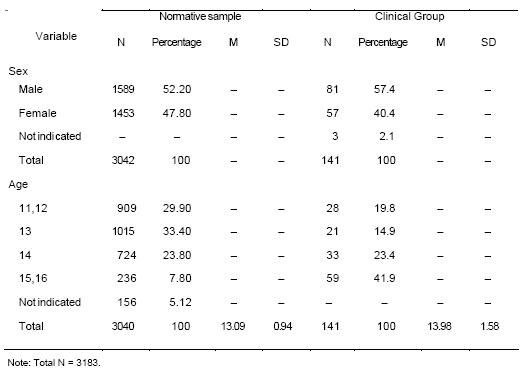
Instruments
The participants were asked to fill in Trauma Symptoms Checklist for Children – TSCC-A (BRIERE, 1996) and Child Abuse Self-Report Scale – CASRS (MOHAMMADKHANI et al., 2003), for assessing TSCC-A convergent and construct validity. Table 2 contains a brief description of TSCC-A validity and clinical scales and sub-scales.
Table 2. Brief Description of TSCC-A validity and clinical scales
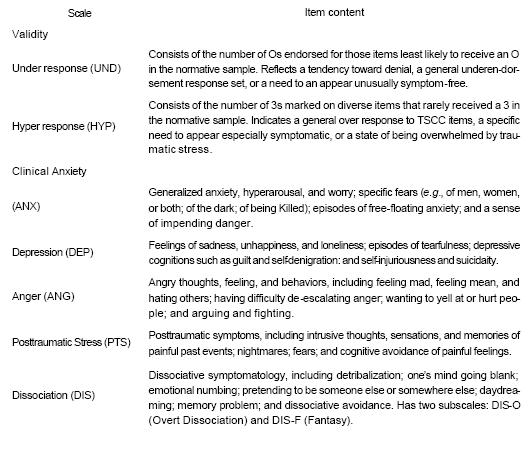
As we need to assess discriminate and convergent validity, each participant was asked to fill in Self-Esteem inventory (COOPERSMITH, 1967) and Child Abuse Self-Report Scale – CASRS (MOHAMMADKHANI et al., 2003).
CASRS is a standard and adjusted scale for Iranian children with 38-Item and four subscales: (a) 14 items for psychological abuse, 11 items for neglect, 8 items for physical abuse and finally 5 items for sexual abuse (MOHAMMADKHANI et al., 2003).
Results
Reliability and Validity
The following section describes the reliability and validity evidences for TSCC-A using alpha cronbach and test-retest.
Reliability
Reliability analysis of the TSCC-A scales in the normative sample demonstrated high internal consistency for two of the scales (a ranges from 0.80 to 0.83), as presents in Table 3. The remaining clinical scales and subscales except DIS-F were moderately relia-ble (a ranges from 0.70 to 0.79). The shorter DIS-F sub-scale being somewhat less reliable (a = 0.53). The two validity scales, UND and HYP had a coefficients of 0.71 and 0.58 respectively. As it is demonstrated in Table 4, the test-retest reliability coefficients for 70 subjects after 2 weeks are also in acceptable level.
Table 3. Internal consistency reliability of TSCC-A scales by a cronbach

Table 4. Reliability of TSCC-A scales by test-retest

Validity
Scale Interco relations
TSCC-A clinical scales and sub-scales Interco relations in the normative sample ranged from 0.51 (DIS-F with ANX) to 0.93 (DIS-O with DIS). As indicated in Table 5, UND scale was negatively correlated with all clinical scales, ranging from –0.28 (with HYP) to –0.68 (with PTS). HYP was most associated with ANX (r = 0.64) and least correlated with DIS -F (r = 0.37) subscale.
Table 5. Interco relations between TSCC-A scales and its sub-scales
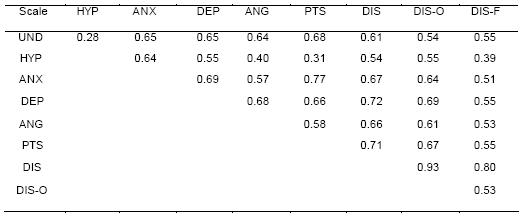
The present study attempted to evaluate the criterion-related validity of TSCC-A using a clinical sample (run away group). It was hypothesized that there would be differences on TSCC-A scales between run away and normative sample. As presented in Table 5, t-test indicates that run away subjects comparing to normative sample, obtained significantly higher scores on the total TSCC-A scales and sub-scale, except for UND. As it was expected, run away subjects obtained significantly lower scores on UND scale (see Table 6).
Table 6. TSCC-A scales and sub-scales differences between normative and clinical groups
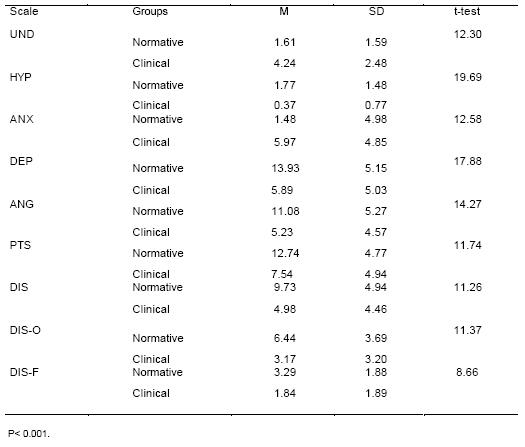
Convergent and discriminant validity
Several studies suggest that TSCC-A scales covary in expected ways with other available measures correlating most with scales sharing similar content (concurrent validity) and least with scales of less similar content (discriminant validity). So in this study, we utilized the “Child Abuse Self Report Scale” – CASRS (MOHAMMADKHANI et al., 2003) to assign concurrent validity and Self-Esteem inventory (COOPERSMITH, 1967) to meas -ure discriminant validity (Table 7). The data suggest significant convergent and discrim-inant validity of the TSCC-A.
Table 7. Correlations between TSCC-A and other psychometric instruments
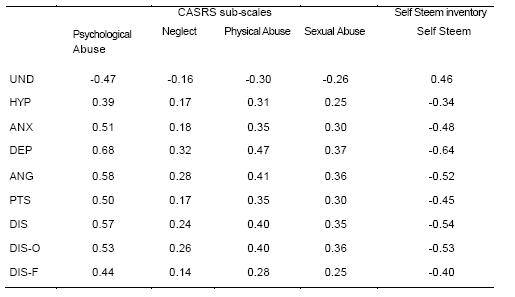
As a measure of posttraumatic stress and related symptoms, the TSCC not only should correlate in meaningful ways with other similar measure, but scale scores also should (a) be higher in samples of children with histories of stressful or traumatic events, (b) increase in the presence of more severe trauma (perhaps especially in PTS and DIS scales). So we examined the relationship between abuse (physical, psychological, sexual, neglect) and TSCC-A scores (Table 8).
The data represent that abused children reported significantly higher symptoms particularly in Depression, Anxiety, Anger scales and Overt Dissociation subscale than nonabused group.
Table 8. The comparison between abused and non-abused children
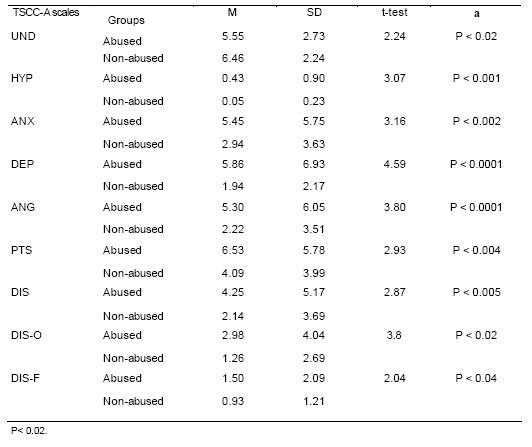
Calculation Norms
Normative data were derived for each TSCC-A scales and sub-scales from the normative sample data based upon age by sex combination. As the T scores for each scale and sub-scale, according to sex and age, are provided in the manual of TSCC-A, we also calculated the means and standard deviations for TSCC-A scales and sub-scales according to each sex and age group (see Table 9 and Table 10).
Table 9. Raw-to T-Score conversions for TSCC-A scales and sub-scales for girls (Age 13-16)
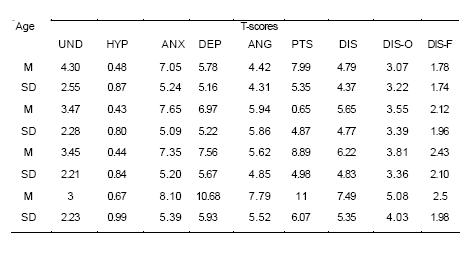
Table 10. Raw-to T-Score conversions for TSCC-A scales and sub-scales for boys (Age 13-16)

Discussion
This study presented data demonstrating the psychometric reliability and validity of the comprising TSCC-A in Iranian student population. We also presented the normative comparisons and T scores, which can be used to interpret the child level of symptomatology. These scores are standardized transformations of the raw scale scores, with the mean of 50 and SD of 10. Similar to percentile scores, T scores provide information about the individual’s scores in relation to the scores of subjects in the standardization sample.
But as lavaliere have written “it is clear that no single measure of children’s func-tioning can infallibly diagnose child abuse, and no single pattern of problems has been found to occur following trauma (abuse)” (ACHENBACH, 1991b), TSCC-A data should not be considered in isolation. The evaluator asked to assess a traumatized child is advised to include the TSCC in a battery of relevant standardized tests, to con-sider test findings in the context of interview and to use corollary information as necessary.
Acknowledgement
We hereby would like to appreciate the National Research Center of Medical Sciences for supporting of this research.
Referências
ACHENBACH, T.M. Manual for the Teacher’s report form and 1991 profile. Burling ton: University of Vermont, Department of Psychiatry, 1991a. [ Links ]
_____ . Manual for the youth Self-Report and 1991 profile. Burlington: University of Vermont, Department of Psychiatry, 1991b. [ Links ]
_____ . Manual for the Child Behavior Checklist 2-3 and 1992 profile. Burling ton: University of Vermont, Department of Psychiatry, 1992. [ Links ]
BECK, A. T. Depression inventory. Philadelphia: Center for Cognitive Therapy, 1978. [ Links ]
BERNSTEIN, E. M.; PUTNAM, F. W. Development, reliability, and validity of dissociation scale. Journal of Nervous and Mental Disorder, v. 174, n. 12, p. 727-735, 1986. [ Links ]
BONEY-MCCOY, S.; FINKELHOR, D. Psychosocial sequelae of violent victimization in a national youth sample. Journal of Consulting and Clinical Psychology, v. 63, n. 5, p. 726-736, 1995. [ Links ]
BRIERE, J. Trauma symptom checklist for children (TSCC) professional manual. Odessa: Psychological Assessment Resources, 1996. [ Links ]
BRYER, J. B.; NELSON, B. A.; MILLER, J. B.; KROL, P. A. Childhood sexual and physical abuse as factors in adult psychiatric illness. American Journal of Psychiatry, v. 144, n. 11, p. 1426-1430, 1987. [ Links ]
COOPERSMITH, S. The antecedents of self-esteem. San Francisco: W. H. Freeman, 1967. [ Links ]
DEROGATIS, L. R. SCL-90; Administration, scoring, and procedure manual-II for the R (revised) version. Towson, MD: Clinical Psychometric Research, 1983. [ Links ]
MOHAMMADKHANI, P.; MOHAMMADI, M. R.; NAZARI, M. A.; SALAVATI, M.; RAZZA - GHI, O. M. Development, validation and reliability of child abuse self-report scale. Medical Journal of the Islamic Republic of Iran, v. 17, n. 1, 2003 [ Links ]
SCHUBINER, H.; SCOTT, R.; TZELEPIS, A. Exposure to violence among inner-city youth. Journal of Adolescent Health, v. 14, n. 3, p. 214-219, 1993. [ Links ]
SICHER, P.; LEWIS, O.; SAGENT, J.; CHAFFIN, M.; FRIEDRICH, W.; CUNNINGHAM, N.; THOMAS, R.; THOMAS, P.; VILLANI, S.; Developing Child Abuse Prevention, Identifi cation, and treatment systems in Eastern Europe. Journal of the American Acade-my of Child and Adolescent Psychiatry, v. 39, n. 5, p. 660-667, 2000. [ Links ]
SINGER, M. I.; ANGLIN, T. M.; SONG, L. Y.; LUNGHOFER, L. Adolescents’ exposure to violence and associated symptoms of psychological trauma. Journal of the American Medical Association, v. 273, n. 6, p. 477-482, 1995. [ Links ]
SURREY, J.; SWETT, C.; MICHAELS, A.; LEVIN, S. Reported history of physical and sexual abuse and severity of symptomatology in women psychiatric outpatients. American Journal of Orthopsychiatry, v. 60, n. 3, p. 412-417, 1990. [ Links ]
 Correspondence
Correspondence
Parvaneh Mohammadkhani Koodakyar
Ave. Evin, Tehran 19834-I.R. Iran
e-mail: parmohamir@yahoo.com
Tramitação
Recebido em setembro de 2006
Aceito em março de 2007













